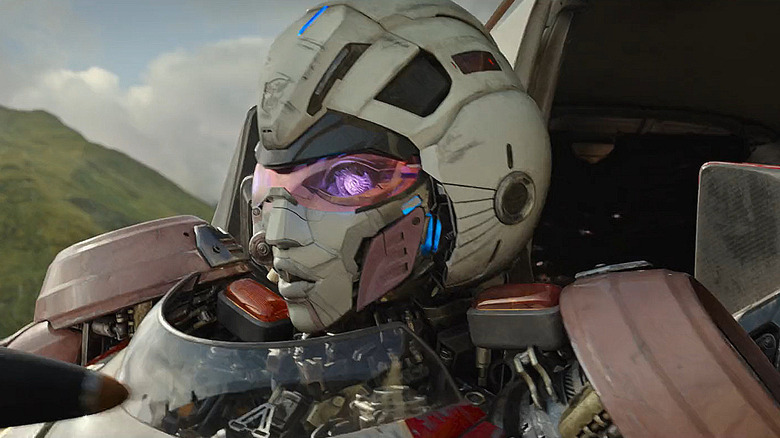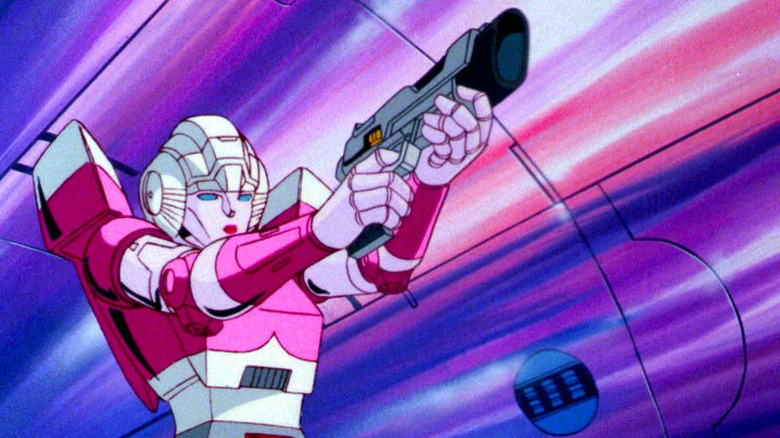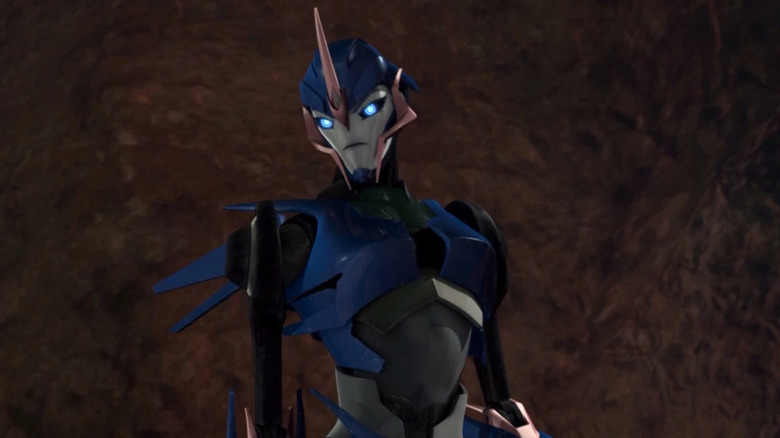Why It Took So Long For Arcee To Appear In The Transformers Movies
Since her debut in the 1986 animated "Transformers" movie, Arcee has been one of the most famous Autobots of all. The default girl Transformer, Arcee rocks a feminine pink-and-white color scheme and either a sports car or motorcycle vehicle mode. She's also had a bit of a rough history.
Arcee was considered for the 2007 "Transformers" film (check out concept art of her here), but like a few other characters, she was cut during development. Co-writer Roberto Orci explained the removal to IGN: "The idea of a female Transformer needs its own explanation, and there just wasn't going to be enough time."
The sequel, "Revenge of the Fallen," featured Arcee, but in one of its many faults, it didn't do much with her. Arcee is one of a trio of female motorcycle transformers; she's painted pink while her sisters are blue and purple (media differs on if the trio are separate robots or a single mind spread across three bodies). This trio is onscreen for about two minutes before getting abrupt deaths in the third act.
Director Michael Bay spoiled his own movie in an interview with MTV News, saying Arcee's death was his decision. Reading his words, he seems to have genuine disdain for the character: "You know what? I didn't like Arcee, so I kill her later, all right? [...] It isn't sad. This is just 'get it out and get it over with.'"
Bay's later sequels largely exclude female Transformers as well. Once he was out of the director's chair, Arcee showed up in the later films, making another small cameo in "Bumblebee" (voiced by Grey DeLisle) and then a supporting role in this year's "Rise of the Beasts" (now voiced by Liza Koshy).
Arcee's difficulties don't end on the silver screen.
No girls allowed
Female Autobots first show up in "The Transformers" season 2 episode, "The Search for Alpha Trion." However, they were all inventions of the episode's writer Beth Bornstein; unlike most of the characters, they weren't based on toys sold by franchise owner Hasbro.
Ron Friedman, writer of the 1986 film "The Transformers: The Movie" and creator of Arcee, explained why. Since Transformers were toys for boys, the powers that be felt there was no need for female characters. But Friedman, whose daughter was a "Transformers" fan, felt it was foolish to leave female fans off the table. Friedman pushed to include Arcee in the movie and won (in fact, he believes he wrote his script before "The Search for Alpha Trion," which he expressed unfamiliarity with). Even so, it took until the 2000s for Arcee to get a proper toy.
For a while, when "Transformers" cartoons bothered including her, Arcee often filled the role of the token girl; see "Transformers: Prime," which gave Arcee a rougher personality and a blue paint job to downplay the original design's femininity. As such, she remains the most famous female character in the franchise, with Blackarachnia from "Beast Wars" in second place. It took until the 2010s for "Transformers" to get truly gender-inclusive, but nowadays, it's hard to find a new TF cartoon or comic where Arcee doesn't star.
For many, this was long overdue. Internet media critic and "Transformers" expert Lindsay Ellis has argued that excluding female Transformers is just as gendered as including them; there being no fembots implies that maleness is the default. Ergo, Orci's aforementioned reasoning is fallacious, especially since gender has become more understood as a sociological construct.
Arcee the *Trans*former
Orci's reasoning wasn't without precedent. In the Marvel "Transformers" comics, the eponymous robots were consistently depicted as a genderless race. As writer Simon Furman put it on his blog: "I've always been fairly outspoken about the redundancy of 'female' Transformers (or 'fembots'). It's not a sexist thing, it's just that they're robots. Why would they have genders at all?"
Most of Furman's "Transformers" work is acclaimed and foundational. His handling of this issue, though, falls short. In 1989, he wrote a UK-exclusive issue where the Autobots create Arcee to appease angry feminists. Even at the time, this played into bad-faith stereotypes. In 2008, he wrote "Spotlight: Arcee." In this story, Arcee was originally a "normal" genderless Transformer who was made female by the mad scientist Jhiaxus. The procedure and resulting changes turned her into an insane murderer.
Writer Mairghread Scott (and co-creator of Windblade, another female Autobot) felt this was the wrong way to handle Arcee's traditional tokenization and said as much. "TLDR version: Arcee's origin is offensive because we don't have any other female origins to balance it," she wrote. Furman was initially upset by Scott's comments on his story, but they've since settled the matter.
Later depictions of this Arcee in IDW's "Transformers" comics (mostly written by John Barber, with input from trans woman fan Jenevieve Frank) didn't negate Furman's story, but they added new context. Arcee is a) one of many female Transformers and b) transgender. Her insanity was due to Jhiaxus' post-treatment abuse ("bad meds"), not the fundamentals of the transition.
I doubt we'll see any of the "Transformers" movies go in-depth on topics like this, but it's clear our understanding of gender has transformed when even children's media addresses it.


